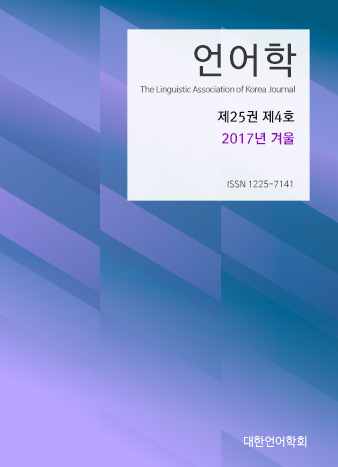대한언어학회 전자저널

25권 4호 (2017년 12월)
- On the Plural Feature and Its Syntactic Implications
-
Jai-Hyoung Cho & Soo Jung Chang
Pages : 1-22
Abstract
Cho, Jai-Hyoung& Chang, Soo Jung. (2017). On the plural feature and its syntactic implications. The Linguistic Association of Korea Journal, 25(4). 1-22. This study addresses the question of whether Korean nouns display parametric variation with the properties of [+arg, -pred] based on Chierchia (1998a, 1998b). Korean bare nouns appear in argument positions, either as singular or plural, and they can function as subjects or objects. The plural marker -tul and the distinctive distribution of quantity-denoting modifiers manifest the fact that Korean, as a classifier language, is not fully masslike. In turn, a classifier language can also have morphological and syntactic systems geared towards the mass/count distinction. These facts lead to the discovery that Korean bare nominals are attenuated mass nouns, rather than strict mass nouns. The current study presents syntactic manifestations of plurality in Korean NPs. Based on Heycock and Zamparelli's (2005) [+LATT] in nominal structures, the incorporation of [+LATT] in NPs is illustrated in terms of the syntactic feature-checking approach. We propose that [+LATT] in classifier languages is distributed in their nouns as default whereas [-LATT] is prevalent in non-classifier languages. Finally, we argue that the classifiers enable Korean nouns with [+LATT] to be individuated as smaller units and the widely used plural marker brings out the property of count nouns as well.
Keywords
# Key Words: bare nouns # classifier languages # the mass/count distinction # plurality # the Nominal Mapping Hypothesis
References
- Borer, H. (2005). Structuring sense 1. Oxford: Oxford Press.
- Bunt, H. C. (1985). Mass terms and model-theoretic semantics. Cambridge: Cambridge University Press.
- Carlson, G. (1977). A unified analysis of the English bare plurals. Linguistics and Philosophy, 1, 413-457.
- Chang, S. J. (2009). Nominal structure and interpretation: On the syntax of the Korean determiner phrase. Unpublished doctoral dissertation, The University of Georgia.
- Cheng, L.-S., & Sybesma, R. (1999). Bare and not-so-bare nouns and the structure of NP. Linguistic Inquiry, 30(4), 509-542.
- Chierchia, G. (1998a). Reference to kinds across languages. Natural Language Semantics, 6, 339-405.
- Chierchia, G. (1998b). Plurality of mass nouns and the notion of “semantic parameter”. In S. Rothstein (Ed.), Events and grammar (pp. 53-103). Dordrecht: Kluwer Academic Publishers.
- Chomsky, N. (1995). The minimalist program. Cambridge, MA: The MIT Press.
- Chung, S. (2000). On reference to kinds in Indonesian. Natural Language Semantics, 8, 157-171.
- Gil, D. (2005). Numeral classifiers. In M. Haspelmath, M. Dryer, D. Gil, & B. Comrie (Eds.), The world atlas of language structures (pp. 226-229). Oxford: Oxford University Press.
- Greenberg, J. (1990 [1975]). Dynamic aspects of word order in the numeral classifier. In K. M. Denning & S. Kemmer (Eds.), On language: Selected writings of Joseph H. Greenberg (pp. 227-240). Stanford: Stanford University Press. [First published 1975. In C. N. Li (Ed.), Word order and word order change (pp. 27-43). Austin: University of Texas Press.]
- Guéron, J. (2006). Generic sentences and bare plurals. In S. Vogeleer & L. Tasmowski (Eds.), Non-definiteness and plurality (pp. 219-234). New York/Amsterdam: John Benjamins.
- Heycock, C., & Zamparelli, R. (2003). Coordinated bare definites. Linguistic Inquiry, 34(3), 443-469.
- Heycock, C., & Zamparelli, R. (2005). Friends and colleagues: Coordination, plurality, and the structure of DP. Natural Language Semantics, 13(3), 201-270.
- Kim, C.-H. (2005). The Korean plural marker tul and its implications. Unpublished doctoral dissertation, The University of Delaware.
- Kim, Y.-W. (2009). Plurality and its syntactic realization. Studies in Generative Grammar, 19(1), 33-58.
- Kim, K.-S. (2010). On the syntax and semantics of Korean classifier constructions. Studies in Generative Grammar, 20(2), 349-368.
- Kobuchi-Philip, M. (2011). The mass hypothesis and Japanese. In Kim et al. (Eds.), Plurality in classifier languages (pp. 283-321). Seoul: Hankookmunhwasa.
- Landman, F. (1989a). Groups I. Linguistics and Philosophy, 12, 559-605.
- Landman, F. (1989b). Groups II. Linguistics and Philosophy, 12, 723-744.
- Lee, J.-S. (2012). Plural marker –tul and its structural implication. Studies in Generative Grammar, 22(4), 753-776.
- Li, Y. (1999). Plurality in a classifier language. Journal of East Asian Linguistics, 8(1), 75-99.
- Link, G. (1983). The logical analysis of plurals and mass terms: A lattice-theoretical approach. In R. Bäuerle, C. Schwarze, & A. von Stechow (Eds.), Meaning, use and interpretation of language (pp. 302-323). Berlin: Mouton de Gruyter.
- Nemoto, N. (2005). On mass denotations of bare nouns in Japanese and Korean. Linguistics, 43(2), 383-413.
- Nomoto, H. (2013). Number in classifier languages. Unpublished doctoral dissertation, University of Minnesota.
- Park, S.-Y. (2008). Plural marking in classifier languages: a case study of the so-called plural marking -tul in Korean. Toronto Working Papers in Linguistics, 28, 281-295.
- Stark, E. (2008). The role of the plural system in Romance. In U. Detges & R. Waltereit (Eds.), The paradox of grammatical change: Perspective from Romance (pp. 57-84). Amsterdam/Philadelphia: John Benjamins.